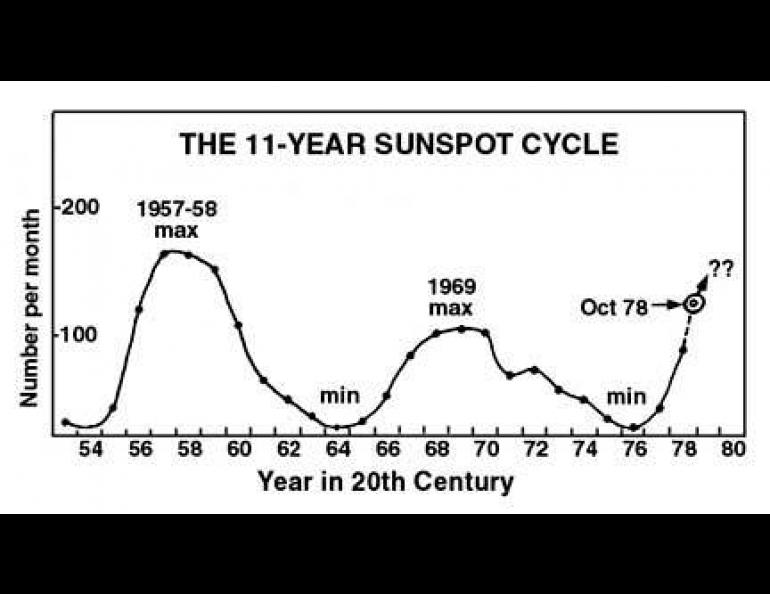
The Aurora Versus CBers
The ups and downs of the 11-year sunspot cycle are somewhat unpredictable. During 1978, the number of sunspots per month rose dramatically and contributed to more auroras and more radio interference in the polar regions. The maximum of the current cycle is predicted for winter 1979-80.
Why have CB communications been particularly difficult in Alaska the past few months? The answer to this question posed by Mr. C. A. Boyd of the Delta Junction area involves the ways of both Man and Nature.
Citizens Band is intended for local, essentially line-of-sight communications. The frequency range for the most popular CB band, near 27 megahertz, is particularly suited to portable short-distance communication. This band is high enough in frequency to permit short antennas and lightweight transmitters and receivers--the higher one goes in frequency, the smaller become the equipment and the power requirements. It is also more costly to build CB equipment designed for high frequency, and the higher in frequency the less able are the radio waves to be refracted or reflected around objects. Thus, if substantially higher frequency is used, for instance the 462 megahertz CB band, it is more costly and more necessary to be truly line-of-sight between radios. The 27 megahertz Citizens Band is low enough in frequency that, at least to a limited extent, the signals can be reflected or bent around hills and valleys to permit non-line-of-sight reception.
Still, the frequency of CB is too high to permit it to bounce off the normal ionosphere located 50 to 400 miles (80 to 600 km) above the earth. Thus, normally, CB transmissions cannot be "skipped" off the ionosphere to be received at distant locations up to several thousands of miles away.
The recent problem with CB in Alaska arises now because the ionosphere is no longer the "normal" one we have been used to the past few years. We are rapidly approaching the maximum of an 11-year solar cycle, a maximum that has all the signs of being higher than the last minimum. In fact, already during October 1978 there were more sunspots than during any month of the last maximum. During sunspot maximum years, there is more aurora at high latitudes, and the ionosphere is made more reflective of radio waves through the action of the same incoming particles that cause aurora.
The last few months it has been usual for the daytime ionosphere over Alaska to be dense enough to reflect radio waves in the 27 megahertz Citizens Band. Consequently, distant signals, typically those from a few hundred to a few thousand miles away, are being skipped in to compete with locally originated signals. The result is often an incomprehensible babble of noise that destroys the usefulness of CB.
This problem has become particularly severe for the first time because this is the first time we are approaching a sunspot maximum period since CB came into heavy use near the auroral zone. Furthermore, the rapid onset of the new solar maximum period during 1978 makes the radiowave pollution problem especially apparent this year.
The interference problem noticed in recent months by CBers near the auroral zone in mostly restricted to the daytime signals being skipped off the high (F-region) ionosphere from locations to the south. A similar problem would exist at night if there were more CBers scattered along the auroral zone in western Canada or eastern Siberia. At night, CB signals are most likely to be reflected off the lower ionosphere (E-region) in a direction parallel to the auroral zone, that is, mostly east-west.
So far, the CB interference problem is mostly restricted to the auroral regions. As we more closely approach the maximum of this solar cycle, the problem likely will spread farther south, just as does the aurora.
How long will the interference problem last? The maximum of this solar cycle is predicted to occur during the 1979-1980 winter. So Alaskan and northern Canadian CBers using the 27 megahertz band can expect serious interference problems well beyond the time of sunspot maximum, at least another two years. The best permanent solution is to assign much higher frequencies to Citizens Band use.





